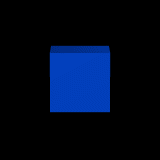User:Dedhert.Jr/sandbox/4
In geometry, rhombicuboctahedron is an Archimedean solid with 24 faces, consisting of 8 equilateral triangles and 18 squares. It is named by Johannes Kepler in his 1618 Harmonices Mundi, being short for truncated cuboctahedral rhombus, with cuboctahedral rhombus being his name for a rhombic dodecahedron.[1]
Construction[edit]
The rhombicuboctahedron may be constructed from a cube by drawing a smaller one in the middle of each face, parallel to the cube's edges. After removing the edges of a cube, the squares may be joined by adding more squares adjacent between them, and the corners may be filled by the equilateral triangles. Another way to construct the rhombicuboctahedron is by attaching two regular square cupolas into the bases of a regular octagonal prism.[2]

A rhombicuboctahedron may also be known as an expanded octahedron or expanded cube. This is because the rhombicuboctahedron may also be constructed by separating and pushing away the faces of a cube or a regular octahedron from their centroid (in blue or red, respectively, in the animation), and filling between them with the squares and equilateral triangles. This construction process is known as expansion.[3]
One way to construct the rhombicuboctahedron by Cartesian coordinates with an edge length 2 is:[4]
Properties[edit]
As a result, the rhombicuboctahedron has 8 equilateral triangles and 16 squares as its faces.[5]
A rhombicuboctahedron with edge length has a surface area:[6]
The rhombicuboctahedron is centrosymmetric: its symmetric is interchangeable by the appearance of inversion center.[7]
Rhombicuboctahedral graph[edit]
Appearances[edit]

In architecture, the rhombicuboctahedron may appear in the National Library located at Minsk.[8]
References[edit]
Notes[edit]
- ^
- Kepler (1997), p. 119
- Cromwell (1997), p. 83
- ^
- Hartshorne (2000), p. 463
- Berman (1971), p. 336, See table IV, the Properties of regular-faced convex polyhedra, line 13. Here, represents the octagonal prism and represents the square cupola.
- ^ Viana et al. (2019), p. 1123, See Fig. 6.
- ^ Shepherd (1954).
- ^
- Cockram (2020), p. 52
- Berman (1971), p. 336, See table IV, the Properties of regular-faced convex polyhedra, line 13.
- ^ a b Berman (1971), p. 336, See table IV, the Properties of regular-faced convex polyhedra, line 13..
- ^ O'Keeffe & Hyde (2020), p. 54.
- ^
- Gan (2020), p. 14
- Cockram (2020), p. 52
Works cited[edit]
- Berman, Martin (1971). "Regular-faced convex polyhedra". Journal of the Franklin Institute. 291 (5): 329–352. doi:10.1016/0016-0032(71)90071-8. MR 0290245.
- Cockram, Bernice (2020). In Focus Sacred Geometry: Your Personal Guide. Wellfleet Press.
- Cromwell, Peter R. (1997). Polyhedra. Cambridge University Press. ISBN 978-0-521-55432-9.
- Gan, Buntara Sthenly (2020). Computational Modeling of Tensegrity Structures: Art, Nature, Mechanical and Biological Systems. Springer. doi:10.1007/978-3-030-17836-9. ISBN 978-3-030-17836-9.
- Hartshorne, Robin (2000). Geometry: Euclid and Beyond. Undergraduate Texts in Mathematics. Springer-Verlag. ISBN 9780387986500.
- Kepler, Johannes (1997). Harmony of the World. American Philosophical Society. This is translated into English by Aiton E. J., Duncan E. M., Field J. V.
- O'Keeffe, Michael; Hyde, Bruce G. (2020). Crystal Structures: Patterns and Symmetry. Dover Publications. ISBN 978-0-486-83654-6.
- Shepherd, G. C. (1954). "A Construction for Wythoffian Polytopes". Canadian Journal of Mathematics. 6 (128–134). doi:10.4153/CJM-1954-015-5.
- Viana, Vera; Xavier, João Pedro; Aires, Ana Paula; Campos, Helena (2019). "Interactive Expansion of Achiral Polyhedra". In Cocchiarella, Luigi (ed.). ICGG 2018 - Proceedings of the 18th International Conference on Geometry and Graphics 40th Anniversary - Milan, Italy, August 3-7, 2018. Springer. doi:10.1007/978-3-319-95588-9.
Notes of improvement[edit]
- Construction of rhombicuboctahedron
- https://books.google.com/books?id=_MjPDwAAQBAJ&pg=PA137 (small rhombicuboctahedron)
- https://books.google.com/books?id=_MjPDwAAQBAJ&pg=PA138
- https://archive.org/details/polyhedra0000crom/page/4/mode/1up?q=rhomb-cub-octahedron&view=theater (unusual die shape of rhombicuboctahedron in Corfe Castle
- Alternative name of rhombicuboctahedron by Johannes Kepler:
- https://books.google.com/books?id=gevlBwAAQBAJ&pg=PA208 (net, vertex figure)
- Rhombicuboctahedron may be used to construct a snub cube, by twisting all of the faces to create rhombic faces, and adding two edges on each rhombic face, forming two new adjacent equilateral triangles: https://books.google.com/books?id=GtNHEAAAQBAJ&pg=PA174
- Octahedral symmetry and non-chiral of rhombicuboctahedron: https://books.google.com/books?id=ILnBkuSxXGEC&pg=PA48
- Coxeter diagram of rhombicuboctahedron: books.google.com/books?id=9BY9AAAAIAAJ&pg=PA17
- Archimedean solid (https://books.google.com/books?id=p_06DwAAQBAJ&pg=PA39)












